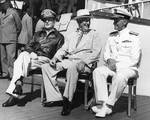Pacific Strategy Conference
Contributor: C. Peter Chen
ww2dbaseWhen US President Franklin Roosevelt gathered his Pacific commanders at Pearl Harbor, Hawaii, United States in Jul 1944 to discuss the direction of the advance on Japan, Douglas MacArthur was convinced that Roosevelt was personally involved in the strategic planning for no other reason than electioneering after his record fourth nomination for presidency. MacArthur decided to upstage Roosevelt by arriving in a long open limousine with elaborate motorcycle escort, accepting the welcome from the cheering crowd. Even before he arrived at Hawaii, he was already unhappy for being forced to leave his troops to attend this "picture-taking junket", as he commented. "In the First War, I never for a moment left my division, even when wounded by gas and ordered to the hospital. I've never before had to turn my back on my assignment", he said. In fact, when he was ordered to go, he was not even informed who was to preside over the meeting, though MacArthur had a good idea it was going to be Roosevelt.
ww2dbaseDuring the meeting itself, though there was no written record of the discussions, MacArthur made the argument that the United States had constitutional responsibility to the people of the Philippine Islands, thus must liberate the islands without further delay. He argued that the conquest of Philippine Islands made more strategic sense than the plan Nimitz presented; with Philippine Islands under Allied control, Japan would become separated from the resources of the South Pacific, therefore limiting her manufacturing capabilities. Without the Philippine Islands, the Allies would also cut off all the Japanese troops south and west of the islands. MacArthur left out the details that a campaign in the Philippine Islands would likely be long and costly.
ww2dbaseNimitz argued for an advance for Taiwan, bypassing the Philippine Islands, noting that it would place the American military at a better position to strike the Japanese home islands than Luzon. Additionally, Nimitz also argued that by holding Taiwan, the island would serve the political purpose of pleasing the Chinese; militarily, it would also open up a gateway to Sino-American operations on the Chinese coast. Nimitz's recommendation, naturally, placed more emphasis upon the usage of the Navy and the Marines, which did not sit well with MacArthur, who already believed that Nimitz was a part of the conspiracy to make the Navy the premier service of the American military. Additionally, MacArthur did not understand how such plan could work. "Just how to neutralize and contain the 300,000 Japanese troops left in [Nimitz's] rear in the Philippines was never clearly explained to me", noted MacArthur. "Admiral Nimitz put forth the Navy plan, but I was sure it was [Ernest] King's and not his own." Roosevelt knew that the plan Nimitz presented had not yet been agreed upon by all US Navy leadership; Raymond Spruance, for example, was not a supporter of the plan for Taiwan, and vouched for an invasion of the Philippine Islands followed by Okinawa, Japan.
ww2dbaseRoosevelt, acting "entirely neutral" during the meeting, made no decisions. However, on 9 Aug, MacArthur received a letter from Roosevelt noting that as soon as he returned to Washington, DC, he would push on the plan that MacArthur recommended. It was possible that, like MacArthur suspected, Roosevelt sided with the general so not to upset him and his vast number of conservative supporters during an election year. So it was decided that MacArthur was to personally oversee the landings on the Philippine Islands, assisted by the entire Third Fleet under the command of MacArthur's old friend William Halsey. Some criticized that the entire Philippine Islands campaign was MacArthur's own obsession for fulfilling his personal promise to the Filipino people. In retrospect, although the Philippine Islands made more strategic sense than Taiwan, MacArthur's campaign to clear every corner of the islands of its Japanese occupiers was rather wasteful in time and resources.
ww2dbaseOn the side, MacArthur also made a personal decision to exclude his Australian contingents from the Philippine Islands campaign, on the grounds that he did not wish to use foreign troops to free American soil.
ww2dbaseSources:
Max Hastings, Retribution
Douglas MacArthur, Reminiscences
William Manchester, American Caesar
Dan van der Vat, The Pacific Campaign
Last Major Update: Aug 2006
Pacific Strategy Conference Interactive Map
Photographs
 |  |
Videos
 |  |
Pacific Strategy Conference Timeline
| 4 May 1944 | The US Joint Chiefs of Staff decided to preliminarily plan landing operations on Taiwan, Philippine Islands, and mainland China. |
| 26 Jul 1944 | Douglas MacArthur and Chester Nimitz presented each of their plans to Franklin Roosevelt on how to approach Japan during the Pacific Strategy Conference in US Territory of Hawaii. MacArthur wanted to target the Philippine Islands to recover American territory, while Nimitz preferred to invade Taiwan which would serve as gateway to both Japan and China. |
| 27 Jul 1944 | US 7th Division conducted a parade for US President Franklin Roosevelt and General Douglas MacArthur on Oahu, US Territory of Hawaii. |
| 9 Aug 1944 | US President Franklin Roosevelt informed Douglas MacArthur that MacArthur's plan to invade the Philippine Islands had been approved, which necessarily meant that Chester Nimitz's plan to land on Taiwan, thus bypassing the Philippine Islands, was rejected. |
Please consider supporting us on Patreon. Even $1 per month will go a long way! Thank you. Please help us spread the word: Stay updated with WW2DB: |

» Leahy, William
» MacArthur, Douglas
» Nimitz, Chester
» Roosevelt, Franklin
Location:
» Hawaii
Ship Participants:
» Baltimore
» Cummings
Related Book:
» American Caesar: Douglas MacArthur 1880-1964
- » 1,182 biographies
- » 337 events
- » 45,119 timeline entries
- » 1,248 ships
- » 350 aircraft models
- » 207 vehicle models
- » 376 weapon models
- » 123 historical documents
- » 261 facilities
- » 470 book reviews
- » 28,409 photos
- » 365 maps
Winston Churchill